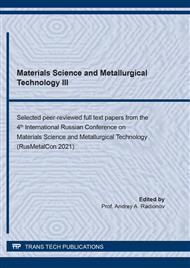[1]
O.V. Zayakin, Development of a rational composition and technology for the production of nickel-containing ferroalloys from poor oxidized nickel ores, URO RAS Publishing House, Yekaterinburg, (2002).
Google Scholar
[2]
R.R. Moskalyk, A. M.Alfantazi, Nickel laterite processing and electro winning practice, Minerals Engineering. 15 (2002) 593-605.
DOI: 10.1016/s0892-6875(02)00083-3
Google Scholar
[3]
O. Yucel, A. Turan, H. Yildirim, Investigation of pyrometallurgical nickel pig iron (NPT) production process from lateritic nickel ores, in: C.E. Suarez (Eds.), TMS 2012, 141th Annual Meeting and Exhibition, TMS, Orlando, 2012, pp.56-64.
DOI: 10.1002/9781118364987.ch3
Google Scholar
[4]
J. Kim, G. Dodbiba, H. Tanno, K. Okayaa, S. Matsuo, T. Fujita, Calculation of low-grade laterite for concentration of Ni by magnetic separation, MineralsEngineering. 23 (2010) 282-288.
DOI: 10.1016/j.mineng.2010.01.005
Google Scholar
[5]
J.A. Johnson, B.C. Cashmore, R.J. Hockridge, Optimization of nickel extraction from laterite ores by high pressure acid leaching with addition of sodium sulphate, Minerals Engineerung. 18 (2005) 1297-1303.
DOI: 10.1016/j.mineng.2005.05.013
Google Scholar
[6]
V.P. Orlov, Iron Ore Base of Russia, Geoinformmark, Moscow, (1998).
Google Scholar
[7]
V.I. Smirnov, Ore Deposits of the USSR, Nedra, Moscow, (1987).
Google Scholar
[8]
H.Y. Sohn, Process Modeling in Non-Ferrous Metallurgy, Elsevier Ltd., Oxford, (2014).
Google Scholar
[9]
G.V. Raynor, V.G. Rivlin, Co-Fe-Ni in Phase Equilibria in Iron Ternary Alloys, Inst. Metals, London, (1988).
Google Scholar
[10]
A.M. Bigeev, M.V. Arslanova, Determination of Slag Consumption for Dephosphorization of Rough Ferronickel Obtained by Partial Reduction from Iron-chromium-nickel Ore of the Khalilovskoye Deposit. Theory and Technology of Metallurgical Production, NMSTU, Magnitogorsk, (2003).
Google Scholar
[11]
A.M. Bigeev, Metallurgy of Steel, Metallurgy, Chelyabinsk, (1988).
Google Scholar
[12]
V.F. Kostin, R.N. Savelyeva, Processes and Units for the Direct Production of Iron, Kirov Publishing House of the Ural Polytechnic Institute, Sverdlovsk, (1983).
Google Scholar
[13]
D.R. Swinbourne, Understanding ferronickel smelting from laterites through computational thermodynamics modeling, Mineral Processing and Extractive Metallurgy. 123(3) (2014) 127-140.
DOI: 10.1179/1743285514y.0000000056
Google Scholar
[14]
A.M. Bigeev, Yu.A. Kolesnikov, Fundamentals of Mathematical Description and Calculations of Oxygen-Converter Processes, Metallurgy, Moscow, (1970).
Google Scholar
[15]
A.K. Saha, M.N.N. Khan, P.K. Sarker, Value added utilization of by-product electric furnace ferronickel slag as construction materials: A review, Resour. Conserv. Recycl. 134 (2018) 10-24.
DOI: 10.1016/j.resconrec.2018.02.034
Google Scholar
[16]
D. Yu, F. Liu, J. Zhang, Thermal upgrading of nickeliferous pyrrhotite tailings for the recovery of nickel in the form of ferronickel alloy, Metallurgical and Materials Transactions B. 50 (2019) 2186-2196.
DOI: 10.1007/s11663-019-01646-5
Google Scholar
[17]
K.L. Bhaskar, B. Bhoi, Iron and nickel enrichment in low grade chromite overburden to produce ferronickel alloys, Transactions of the Indian Institute of Metals. 74 (2021) 1321-1332.
DOI: 10.1007/s12666-020-02176-4
Google Scholar
[18]
G.I. Zhmoydin, I.S. Kulikov, Atlas of Slags, Metallurgy, Moscow, (1985).
Google Scholar
[19]
V.A. Voropaev, Production of Steel from Phosphorous Cast Iron in Steel-making Units, Metallurgy, Moscow, (1982).
Google Scholar
[20]
V.A. Voropaev, Redistribution of Phosphorous Cast Iron, Technika, Kiev, (1971).
Google Scholar


